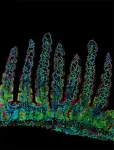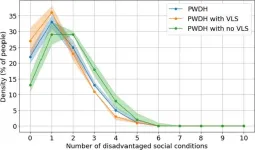(Press-News.org) Like humans, mice will compete over territory and mates, and show increased confidence in their fighting skills the more they win. At first, a brain chemical called dopamine is essential for young males to master this behavior. But as they gain experience, the chemical grows less important in promoting aggression, a new study shows.
Dopamine has been linked to male aggression for decades. How past experiences might influence this relationship, however, had until now been unclear.
In experiments in rodents, a team led by researchers at NYU Langone Health boosted activity in dopamine-releasing cells in a part of the brain called the ventral tegmental area. The findings revealed that in inexperienced male fighters, this led the animals to attack for twice as long as they would have fought naturally. When the cells were blocked, the novice mice would not fight at all.
By contrast, this pattern did not hold true in males that had extensive fighting experience. Whether or not dopamine-releasing cells were boosted or blocked, the duration of attack did not change. Notably, though, the more clashes a mouse won, the more fights it would start in the future.
“Our findings offer new insight into how both ‘nature’ and ‘nurture’ shape aggression in males,” said study senior author Dayu Lin, PhD. “While aggression is an innate behavior, dopamine — and fighting experience — is essential for its maturation during adulthood,” added Lin, a professor in the Departments of Psychiatry and of Neuroscience at NYU Grossman School of Medicine.
A report on the findings is publishing online Jan. 22 in the journal Nature.
Building on their evidence for the role of dopamine in learning aggression, authors set out to better understand the brain mechanisms that might explain it. To do this, the team prevented cells in the ventral tegmental area of the brain from releasing dopamine into another region called the lateral septum, a site known to regulate aggression. They found that novice males would never learn to fight, but those with previous fighting experience would continue to engage in aggressive behavior. Similarly, promoting dopamine release in this area of the brain boosted hostility in rookies but had no effect on veterans.
This suggests that the lateral septum is a key brain site for dopamine to promote “aggression learning” in rodents and likely in other mammals, including people, says Lin, who is also a member of NYU Grossman School of Medicine’s Institute for Translational Neuroscience.
The team also measured dopamine release in the lateral septum as the animals gained fighting experience. They found that the chemical surges the most on the day they first decide to attack. As the mouse becomes more experienced with fighting, this dopamine spike becomes less dramatic, supporting a central role of the chemical in initial aggression learning.
Importantly, the researchers also found that dopamine did not appear to play a similar role in female aggression. In fact, manipulating dopamine levels did not affect aggressive behaviors in female mice in any way.
According to Lin, the results may offer new insight into addressing mental health conditions marked by intense shifts in mood and behavior, such as schizophrenia, bipolar disorder, and borderline personality disorder. Antipsychotic drugs that interfere with dopamine release are commonly used to treat such diseases, as well as to suppress violent behavior in psychiatric patients.
“Our results suggest that targeting dopamine may not be an effective tool when treating those with a long history of aggression,” said Lin. “As a result, healthcare providers may need to consider a patient’s history, as well as their age and sex, when considering which therapy to use.”
Lin adds that the results may also explain why antipsychotic drugs are known to have a stronger and longer-lasting effect in children than in adults, for whom aggression often returns once they stop receiving medication.
That said, Lin cautions that while mice share similar brain chemistry with people and that the current findings echo human clinical results, more research will be needed to demonstrate the impact of past behavior on the effectiveness of antipsychotic medications in humans.
Funding for the study was provided by National Institutes of Health grants R01MH101377, R01MH124927, U19NS107616, U01NS11335, U01NS12082, P30DA048736, and R01MH133669. Further study funding was provided by the Vulnerable Brain Project.
In addition to Lin, other NYU Langone researchers involved in the study are Bingqin Zheng, MS; Xiuzhi Dai; Xiaoyang Cui, BS; Luping Yin, PhD; Jing Cai, PhD; and Nicolas Tritsch, PhD. Other study investigators include Yizhou Zhuo, PhD, and Yulong Li, PhD, at the Peking University School of Life Sciences in Beijing; and Larry Zweifel, PhD, at the University of Washington in Seattle. Bing Dai, PhD, a former graduate student at NYU Langone and a current postdoctoral associate at the Massachusetts Institute of Technology in Cambridge, served as the study lead author.
###
About NYU Langone Health
NYU Langone Health is a fully integrated health system that consistently achieves the best patient outcomes through a rigorous focus on quality that has resulted in some of the lowest mortality rates in the nation. Vizient, Inc., has ranked NYU Langone the No. 1 comprehensive academic medical center in the country for three years in a row, and U.S. News & World Report recently placed nine of its clinical specialties among the top five in the nation. NYU Langone offers a comprehensive range of medical services with one high standard of care across six inpatient locations, its Perlmutter Cancer Center, and more than 300 outpatient locations in the New York area and Florida. With $14.2 billion in revenue this year, the system also includes two tuition-free medical schools, in Manhattan and on Long Island, and a vast research enterprise with over $1 billion in active awards from the National Institutes of Health.
Media Inquiries:
Shira Polan
Phone: 212-404-4279
shira.polan@nyulangone.org
END
Fighting experience plays key role in brain chemical’s control of male aggression
Findings may shed light on waning effectiveness of antipsychotic drugs
2025-01-22
ELSE PRESS RELEASES FROM THIS DATE:
Trends in preventive aspirin use by atherosclerotic cardiovascular risk
2025-01-22
About The Study: Following landmark clinical trials and changes in guideline recommendations, self-reported primary prevention aspirin use decreased among older adults and adults with low atherosclerotic cardiovascular disease (ASCVD) risk for whom aspirin was not recommended, but also decreased among adults with higher ASCVD risk for whom aspirin may still be recommended. Despite these reductions, many patients with limited likelihood to benefit reported continuing to take aspirin.
Corresponding Author: To contact the ...
Sex differences in long COVID
2025-01-22
About The Study: This study found that female sex was associated with an increased risk of long COVID compared with male sex, and this association was age, pregnancy, and menopausal status dependent. These findings highlight the need to identify biological mechanisms contributing to sex specificity to facilitate risk stratification, targeted drug development, and improved management of long COVID.
Corresponding author: To contact the corresponding author, Dimpy P. Shah, M.D., Ph.D., email ShahDP@uthscsa.edu.
To ...
Medically recommended vs nonmedical cannabis use among US adults
2025-01-22
About The Study: The results of this study showed that adults ages 18 to 49 reporting medical-only or medical-nonmedical cannabis use vs nonmedical-only use had higher prevalence of cannabis use disorder at all severity levels and reported more frequent cannabis use. These findings suggest that medically recommended cannabis is not associated with reduced addiction risk compared with nonmedical use.
Corresponding author: To contact the corresponding author, Nora D. Volkow, M.D., email nvolkow@nida.nih.gov.
To access the embargoed study: ...
Spanish scientists discover how the gut modulates the development of inflammatory conditions
2025-01-22
A study led by David Sancho at the Centro Nacional de Investigaciones Cardiovasculares (CNIC) in Madrid reveals how an increase in intestinal permeability allows the natural gut bacteria to cross the intestinal barrier and reach the bone marrow, where they induce epigenetic changes—modifications that alter gene activity without affecting DNA sequence—in the stem cells that give rise to immune cells. The epigenetic changes induced by the translocated gut bacteria generate “trained” immune cells primed to respond more efficiently to future infections. However, this same ability to amplify the immune response can also aggravate the inflammatory conditions such as ...
Compact comb lights the way for next-gen photonics
2025-01-22
In the world of modern optics, frequency combs are invaluable tools. These devices act as rulers for measuring light, enabling breakthroughs in telecommunications, environmental monitoring, and even astrophysics. But building compact and efficient frequency combs has been a challenge—until now.
Electro-optic frequency combs, introduced in 1993, showed promise in generating optical combs through cascaded phase modulation but progress slowed down because of their high power demands and limited bandwidth. This led to the field being dominated by femtosecond lasers and Kerr soliton microcombs, which, while effective, require complex tuning and ...
New research reveals how location influences how our immune system fights disease
2025-01-22
Seattle, WASH.—January 22, 2025—The human immune system is like an army of specialized soldiers (immune cells) each with a unique role to play in fighting disease. In a new study published in Nature, led by scientists at the Allen Institute, La Jolla Institute for Immunology, and UC San Diego, researchers reveal how cells known as tissue-resident memory CD8 T cells, play unique and specialized roles based on where they are located within the small intestine. Tissue-resident memory cells provide a local first ...
AI in cell research: Moscot reveals cell dynamics in unprecedented detail
2025-01-22
Thanks to a new technology called Moscot (“Multi-Omics Single-Cell Optimal Transport”), researchers can now observe millions of cells simultaneously as they develop into a new organ—for example, a pancreas. This groundbreaking method was developed by an international research team led by Helmholtz Munich and has been published in the renowned journal Nature.
Until now, biologists had only a limited understanding of how cells develop in their natural environment—for instance, when they form an organ in the ...
New study finds social programs could reduce the spread of HIV by 29%
2025-01-22
January 22, 2025
New Study Finds Social Programs Could Reduce the Spread of HIV by 29%
Although HIV was used as a case study, the UMass Amherst researchers say their assessment tool has applications for other diseases
AMHERST, Mass. — Researchers at the University of Massachusetts Amherst have quantified the impacts of a constellation of social factors on the spread of HIV. Their study, published in Health Care Management Science, found that a hypothetical 100% effective intervention addressing barriers to HIV treatment and care from depression, homelessness, ...
SIDS discovery could ID babies at risk of sudden death
2025-01-22
New University of Virginia School of Medicine research revealing the fingerprints of Sudden Infant Death Syndrome within blood samples could open the door to simple tests to identify babies at risk.
The findings also represent an important step forward in unraveling the causes of SIDS, an unexplained condition that is the No. 1 killer of babies between amonth and a year old.
The UVA researchers analyzed blood serum samples collected from infants who died ...
Ozone exposure linked to hypoxia and arterial stiffness
2025-01-22
Ozone (O3) exposure may reduce the availability of oxygen in the body, resulting in arterial stiffening due to the body’s natural response to create more red blood cells and hemoglobin, according to a study published today in JACC, the flagship journal of the American College of Cardiology.
“Researchers found that even brief exposure to elevated ozone levels reduced blood oxygen saturation, triggered hypoxia-related biomarkers, and increased arterial stiffness, highlighting the novel connection between ozone exposure and arterial stiffness, demonstrated through comprehensive biomarker analysis in a high-altitude ...
LAST 30 PRESS RELEASES:
Electrodes created using light
Second-hand gift-giving is a well-deliberated decision
How human interaction drove evolution to make bears less aggressive
National Poll: Few parents offer teens guidance on healthy eating during holiday season
Cannabis derivatives could provide new ovarian cancer treatments
Raising strong yeast as a petroleum substitute
Clues to the origin of hot Jupiters hidden in their orbits
Canada’s reduced pledge to Global Fund will impact domestic health
1 in 4 children with major traumatic injuries not cared for in pediatric trauma centres
Duke and Duke-NUS’ joint cross-population research to uncover "East-West" differences in disease and care
Scientists to ‘spy’ on cancer- immune cell interactions using quantum technology breakthrough
Tech savvy users have most digital concerns
Making lighter work of calculating fluid and heat flow
Normalizing blood sugar can halve heart attack risk
Lowering blood sugar cuts heart attack risk in people with prediabetes
Study links genetic variants to risk of blinding eye disease in premature infants
Non-opioid ‘pain sponge’ therapy halts cartilage degeneration and relieves chronic pain
AI can pick up cultural values by mimicking how kids learn
China’s ecological redlines offer fast track to 30 x 30 global conservation goal
Invisible indoor threats: emerging household contaminants and their growing risks to human health
Adding antibody treatment to chemo boosts outcomes for children with rare cancer
Germline pathogenic variants among women without a history of breast cancer
Tanning beds triple melanoma risk, potentially causing broad DNA damage
Unique bond identified as key to viral infection speed
Indoor tanning makes youthful skin much older on a genetic level
Mouse model sheds new light on the causes and potential solutions to human GI problems linked to muscular dystrophy
The Journal of Nuclear Medicine ahead-of-print tip sheet: December 12, 2025
Smarter tools for peering into the microscopic world
Applications open for funding to conduct research in the Kinsey Institute archives
Global measure underestimates the severity of food insecurity
[Press-News.org] Fighting experience plays key role in brain chemical’s control of male aggressionFindings may shed light on waning effectiveness of antipsychotic drugs



